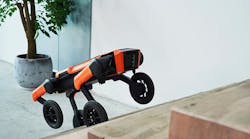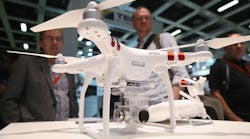In the realm of animation, anything can happen, as long as the person drawing has the sufficient skill and imagination. Roadrunners can outfox coyotes, a sponge can wear pants, and giant robots can battle servo a servo for national pride.
On occasion, though, the imaginations of real-world engineers can equal or even surpass that of the artists who compelled us to spring out of bed on Saturday morning to gorge on children's programming as unhealthy and artificial as our breakfast cereal was.
Such is the case with the aforementioned jingoistic robots. It's the premise of Mobile Suit Gundam, an anime that began in 1979, which spawned several spin-offs and imitators. It's also something that may be happening very soon, if the pending giant robot duel between the U.S. and Japan comes to fruition.
Whether you believe it's incredibly awesome or a horrific waste of the talented minds at U.S.-based MegaBots and Japan's Suidobashi Heavy Industries, this friendly competition is as inspired by Gundam as NASA's architects were by Jules Verne novels.
There must have been some extremely smart kids out there watching those shows who vowed to themselves, "When I grow up, I'm going to make one of those giant robots."
From those childhood ambitions, we will get more than just a few rounds of mechanized carnage. The bi-products of the space race were microchips, cell phones and countless other inventions we now consider necessities. There's no doubt a robotics race would produce some invaluable tech, too.
In fact, we already have more than you may realize, working in our factories and training in our laboratories. And much of it mirrors the cartoons of the past 40 years.
To demonstrate how advanced this industry is, we decided to test the metal of existing robots against their animated doppelgangers. (OK, fine, it's because we love robot fights.)
WALL-E vs. ZRR
Animated: The lonely mission of the last WALL-E (Waste Allocation Load Lifter – Earth-class) was to pick up and compact garbage in the hopes of making the planet habitable again. He passed the time in this dystopian future by decorating his home with recycled antiques, making him the Earth's last hipster as well.
Engineered: The ZenRobotics Recycler, developed in Finland, may not have the charisma or romantic pluck of everyone’s favorite trash compactor, but it makes up for it in work ethic. The ZRR can rapidly pick and sort wood, stone, cardboard and rigid plastics weighing as much as 44 lb from the conveyor belt, at a pace of 2,000 pieces an hour. Like WALL-E, this system has the ability to learn and is efficient enough to run off solar power.
The Fight: The ZRR has the size and speed, but it’s operates in a closed system, much like Auto on the space liner Axiom. WALL-E’s considerably more mobile and willing to cannibalize other machines for immortality. He would make short work of the ZRR, disassembling it to the tune of "Singing in the Rain," perhaps. And if things looked grim, EVE would blow that environmentally friendly claw game all the way back to Helsinki.
Winner: Wall-E
H.E.R.B.I.E. vs. Sawyer
Animated: H.E.R.B.I.E. (Humanoid Experimental Robot B-Type Integrated Electronics) appeared on the animated Fantastic Four series from 1978 as a replacement for the Human Torch, whose rights were owned by Universal at the time. The only positive thing to say about this robot is that it’s not the worst incarnation of Fantastic Four ever.
Engineered: Sawyer, created by Rethink Robotics, only has one arm, and is smaller (42 lb and 3.3 feet tall) than its “big brother,” Baxter, but could very well change the manufacturing industry as we know it. One study already predicts that 68% of high tech jobs could be performed by robots in the near future. This one already has an impressive resume. The $29,000 robo-worker has an amazing range of motion, seven degrees of freedom, and the fine motor skills to test circuit boards and tend machines. That googly-eyed face is also an interactive display.
The Fight: For all the fear that Sawyer is going to steal your job, the creators say they designed the robot to collaborate with human workers and does the jobs companies can’t get people to do. It's a true team player. In contrast, H.E.R.B.I.E. took a perfectly good human (torch)’s job, and often got under the Thing's thick skin. With no one willing to back up the annoying robot pastiche, Sawyer would quickly clip H.E.R.B.I.E.’s circuits faster than the recent “Fantastic Four” theatrical run.
Winner: Sawyer
Bender vs. Twister
Animated: As far as industrial bending units go, none can match the skill of Bender Bending Rodriguez ("Futurama") in criminal mischief, narcissism, drinking, smoking, lying, cheating, and more stealing. Oh, and he’s quite adept at bending steel girders for use in manufacturing suicide booths.
Engineered: The Twister RB50 is a CNC controlled pipe bending machine with two to six bending heads for 20-60 mm diameter pipes. The 13-foot high, 1100-lb bender can complete multiple bends in one pipe at a maximum 210 degree angle. It also doesn't drink on the job and has low emissions.
The Fight: If you think Bender would fight fair, you do not know your bending units.
Winner: Bender
Voltron vs. Motoman
Animated: When the five human-operated robotic lions emerge from their respective lairs and combine, they create Voltron, Defender of the Universe. That’s a pretty tall task, even if you have one of the biggest, baddest sword not made by Hattori Hanzo.
Engineered: The Yaskawa Motoman-MH24 may look like a typical six-axis robot. Don’t let the blue steel fool you; this machine has the spirit of a warrior. A samurai, actually, by the name of Isao Machii. The iaijyutsu master wore body sensors to track his powerful, precise sword movements, which were then downloaded to the Motoman. The result is a robot with a 5 ½-foot reach that can slice a pea pod in half.
The Fight: The Japanese have graciously given the world both Voltron and Motoman. We have to assume that if Voltron were to challenge Motoman, the Yaskawa engineers would scale the robot appropriately and the event would the pay-per-view event of the century. Voltron is controlled by six pilots with various martial arts skills, while Motoman has the moves of one of the world’s top sword masters. Even the slightest human error would be exploited by the ruthless blue robot.
Winner: Motoman
Ravage vs. MIT Cheetah Robot
Animated: The agile Decepticon spy, Ravage, is a black panther that transforms into a cassette tape. It doesn't get more '80s than that.
Engineered: Due to custom high-torque electrical motors and advanced sensors, MIT's cheetah bot can run faster than 13 mph and hurdle obstacles at a full gait, all autonomously. It's nearly as quiet as the real thing, too, making it the last robot you want to achieve sentience. It would bring a new meaning to "Good Will Hunting."
The Fight: Ravage has frikking' rocket launchers on it's legs, and MIT's mecha-cat is currently clawless. Not a very fair fight. The cheetah bot is funded by DARPA, though, so with a few military upgrades, maybe Boeing's anti-drone laser, the Decepticon doesn't stand a chance. (The bad guys never win anyway.)
Winner: MIT Cheetah Bot
Baymax vs. CMU Robotic Arm
Animated: The inflatable personal healthcare companion/ crime fighter from "Big Hero 6" has high-tech sensors to diagnose illnesses and a squishy body to dole out hugs. He also knows kung fu.
Engineered: Carnegie Mellon University's robotic arm was developed in its Quality of Life Technology Center to safely perform delicate work such as feeding patients and giving sponge baths. As baby boomers get older, it's an industry robotics could play a vital role in.
"Robots as caregivers, it's going to happen," says Chris Atkeson, professor of robotics at CMU. "There are a lot of people who need physical help: people with disabilities, older people."
The Fight: Maybe these two would arm wrestle, but neither would hurt the other. After all, Baymax's doughy body is actually based on the robotic arm, which "Big Hero 6" director discovered while doing research for the movie. Baymax got the program so much publicity, CMU tried to raise enough money to build a real Baymax when the movie was released in Nov. 2014.
Winner: Draw
Final Verdict:
Even though they have to take physics, financing and functionality in account, present day engineers have edged out the animators, 3-2. All this really means is that the line between the technology we can think up and the technology that can be created is thinner than ever, if it still even exists.
If you have any other examples or want to argue about robots, please comment below or reach us onFacebook!










